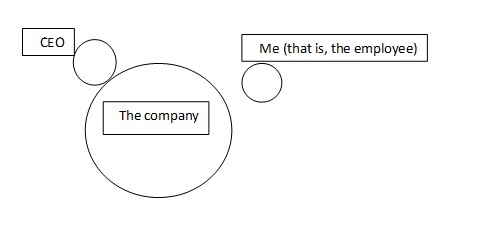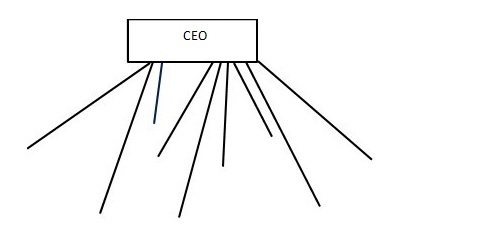One of the questions I ask when first starting work with a new company and getting to know it, is about the organizational structure. I ask various people to draw it. I rarely get identical answers. Everyone draws a different structure. That is, employees and managers don’t know who manages whom. Often they don't even know who their own manager is.
Who's the CEO?
About a year ago I started working with a medium-sized company, about 200 employees, and a shift-supervisor listed as CEO a consultant who would come to the site once a week. I asked what job the actual CEO did, and he said he had no idea.
When I presented this at the end of my initial time learning the company, it was dismissed with a flippant remark about the supervisor. Even if he wasn't the sharpest tool in the shed, he must know the management chain of the company.
If a shift-supervisor doesn’t know who the CEO is, he's probably isn't the only one. It's the management's duty to make the organizational structure clear and known by everybody, and for that purpose it needs to be advertised on bill-boards.
In the above case, the aforementioned consultant used to walk the production floor during her one-day-a-week visit and give assertive instructions. Contrastingly, the CEO tried not to give employees any direct instructions, and work with a clear management chain-of-command, as he should.
An unclear organizational structure is an invitation for mistakes and also a reflection of deep problems.
Before I go into detail, I'd like to discuss a few more examples.
I'm Senior but Have No responsibility
In a different company, the most senior employee working under the CEO the following drawing:

What she meant to communicate with this scheme was that she has no defined role (which was indeed the case), she doesn’t want to take responsibility but she's a senior employee with tenure and isn't one of the engineers in the company.
Two other senior engineers mentioned their role isn’t clear to them. Even though the CEO was clear on each of their roles, they were not.
When we, later, defined their role and place in the organizational structure, there was quite a stir. They wanted a clear definition of their job and place in the hierarchy, but the definition they got wasn't what the expected or hoped for. Opaqueness can be easier sometimes, but is never better for the company.
By the way, notice the creativity in presenting a hierarchy with circles.
The CEO Who Tries to Directly Manage Everybody
Often you'll see CEOs who are involved in everything that happens in their company, want to control every activity and don’t delegate. This is how a VP of marketing once drew the organizational structure of a company I worked with, where the CEO, he said, constantly give instructions to employees, bypassing the chain-of-command:

A second managers in that company drew an empty square and said there is no set structure, the CEO directly manages everybody.
Joint CEOs
The most difficulty arises when there are joint CEOs. Often they will walk on egg shells and never directly address anything. As a result, a lot of grey areas are created in these companies.
For example, a few years ago I worked with two such CEOs, who were also the owners. They got along well, but never clearly defined their respective areas of responsibility.
When I asked each of them, separately, to draw the company's organizational structure, the results were similar, but not identical. There were a few employees neither of them saw as under their supervision. So, you must ask, how did the business function?
A company can function with grey areas which no one manages, as well as with overlaps. Overlapping of management happens when multiple managers consider themselves the supervisors of the same employees. Will the company collapse? No, of course not, but the company will function less effectively, and there can even develop personal disputes which will hurt the company.
What Does a Defined Organogram Give Us?
The examples I described above aren’t rare or unique. I meet the like in almost every company I work with.
An organogram is a diagram, or a drawing, of the organizational structure, and a clear definition of it clarifies the division of managerial responsibility. When it's advertised on company bill-boards, every manager and every employee learns the organizational hierarchy. Who manages whom, and especially where they're positioned.
No CEO should draw an organogram where lines are drawn from the CEO to every employees, or where there are employees with no listed manager.
Creating an organogram requires an in-depth discussion and decision making.
Why It's Important to Advertise?
Every company with an ISO certification has a drawing of its organizational structure on file somewhere. It’s a requirement for the certification - and as long as it's not advertise and hidden in the quality-control files, it's meaningless.
The organogram is meant to define the organization's hierarchy. So that every manager and employee knows it. If the organogram isn’t advertise, how can they know it?
Advertising has another important function: as long as it's hidden on file, the CEO doesn’t truly deal with the need to make decisions in regards to management hierarchy.
Indeed, some of the above examples are from companies who had an ISO certification, and an organogram on file.
Defining Roles and Responsibilities
Advertising an organogram is important, but not enough. When every manager is familiar with their place in the hierarchy and managerial scope, it's essential to define responsibilities, authority, and measurable goals.
I've written about this subject previously, and you can read the article here.
Summary and Recommendation
In this article I showed the need, even necessity, to create an organogram, or a drawing of the organizational structure, and advertise it throughout the company. This will prevent grey areas which are not managed, or overlapping management.
The organogram's importance can be seen even in the most trivial order. An order which insures every employee and manager knows who manages them, and whom they manage.
If you are interested in my professional help, personally or for your company, the best way is to send a request through the Get in Touch form in my website (here).












 My First Book: Manage! Best Value Practices for Effective Management
My First Book: Manage! Best Value Practices for Effective Management